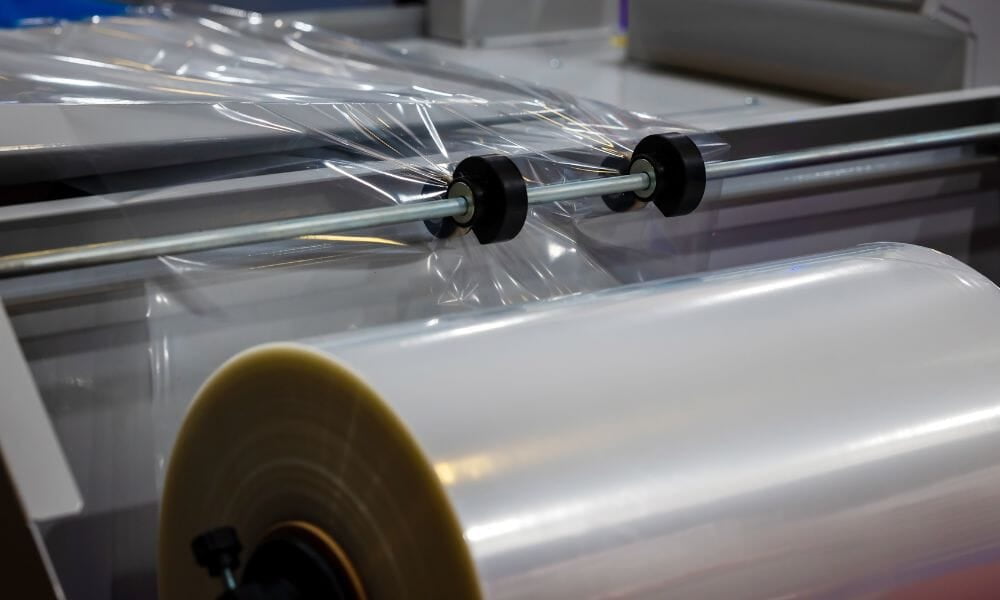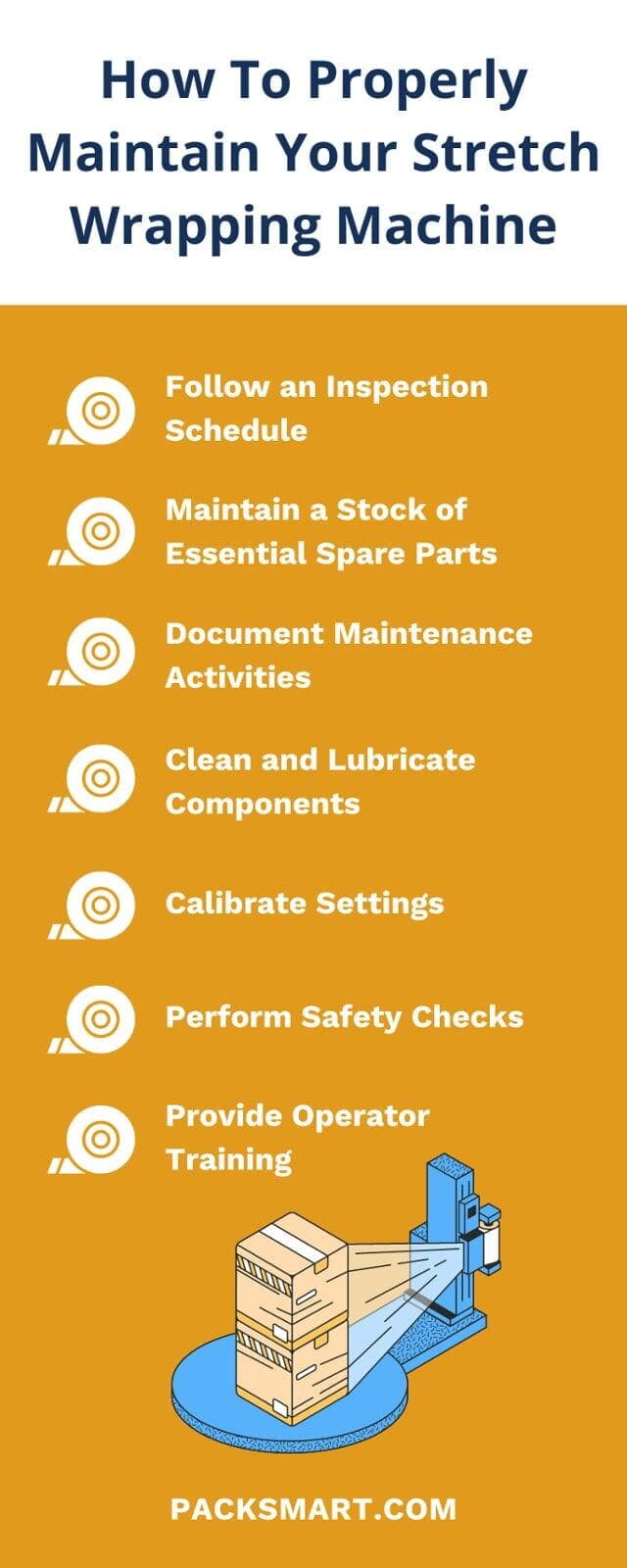
Stretch wrapping machines secure goods on pallets for safe and reliable transport. Regular maintenance extends the lifespan of this equipment, minimizes downtime, keeps equipment operators safe, and ensures reliable product protection. Discover how to properly maintain your stretch wrapping machine to keep your packaging equipment functional and efficient.
Follow an Inspection Schedule
Routine inspections are the first line of defense against premature wear and breakdowns. Schedule inspections to examine the stretch wrapping machine for signs of wear or damage. Pay special attention to critical components such as the film carriage, load rollers, and cut and clamp mechanisms.
Signs such as unusual noises, decreased performance efficiency, inconsistent wrapping, or visible wear and damage on parts can all indicate that a component needs to be examined and possibly replaced. Detecting issues early can significantly reduce the risk of operational disruptions. Ensure your maintenance team records the findings of each inspection to track the equipment’s condition over time and anticipate future maintenance needs.
Maintain a Stock of Essential Spare Parts
Replacing parts before they fail not only ensures the continuous operation of the stretch wrapping machine but also significantly reduces the risk of unscheduled downtime and costly repairs. To guarantee compatibility and reliability, source replacement parts from reputable suppliers or directly from the manufacturer. Maintaining a stock of essential spare parts can further minimize operational disruptions, enabling quick and efficient replacements as needed.
Document Maintenance Activities
Document all maintenance activities, including scheduled inspections, repairs, parts replacements, and calibrations. This documentation serves as an invaluable reference for both immediate troubleshooting and long-term management of the machine’s upkeep. Through meticulous record-keeping, warehouse managers can analyze trends, anticipate potential future failures, and budget for maintenance-related expenses.
Clean and Lubricate Components
Over time, dust and debris can accumulate in the working parts of the stretch wrapping machine, which can lead to friction and increased wear. Clean the machine regularly, focusing on removing accumulated debris from rollers, conveyors, and the film delivery system.
Lubrication is equally important. Apply appropriate lubricants to moving parts in accordance with the manufacturer’s specifications. Doing so reduces friction, prevents overheating, and facilitates unimpeded motion, thereby maintaining optimal functional performance and prolonging the equipment’s life.
Use the following cleaning and lubrication tips to optimize your machine:
- Apply approved cleaning agents correctly: Employ non-corrosive cleaning agents specifically designed for industrial machinery and avoid using water or liquids directly on electrical components.
- Schedule regular lubrication: Routinely lubricate parts using lubricants recommended by the manufacturer to ensure machine components operate smoothly and efficiently.
- Inspect for residue buildup: Regularly check the film carriage and rollers for adhesive residue from the stretch film. Gently clean these areas with a suitable solvent to maintain performance and prevent premature wear.
- Adhere to the manufacturer’s guidelines: Always refer to the manufacturer’s maintenance manual for specific cleaning and lubrication instructions.
Calibrate Settings
An improperly calibrated stretch wrapper may result in under- or over-wrapped pallets, making the pallets more vulnerable to damage or causing packaging material waste. Regularly calibrate the machine to ensure it wraps with the correct tension and consistent application. Adjust the settings according to the type of load and film used, taking care to follow the manufacturer’s guidelines.
Signs that indicate the need for recalibration include inconsistent film tension, frequent film breaks, and uneven or insecure wrapping. Correct calibration prevents possible damage to products and machinery and enhances cost savings and cargo security.
Perform Safety Checks
Ensure that all safety mechanisms on your stretch wrapping machine, such as emergency stop buttons, guards, and fences, are intact and functioning properly. Regular checking of these safety features helps prevent accidents and injuries, maintaining a safe environment for operators.
If you find compromised safety elements, take immediate corrective action to repair or replace the affected parts. A proactive approach to safety fortifies not only the well-being of your personnel but also safeguards against potential liability issues.
Provide Operator Training
Employers must provide comprehensive training to all personnel who operate the stretch wrapping machine. This training should cover not just the proper use of the machinery but also fundamental maintenance procedures, including cleaning, lubrication, and safety checks.
Utilize training materials, manuals, and videos provided by the manufacturer to ensure that training is aligned with specific machinery guidelines and best practices. An educated operator can recognize early signs of mechanical issues and act swiftly to mitigate them. Empower your operators with knowledge and encourage a culture of accountability and upkeep.
Ensure Proper Load Handling
Correct loading practices are crucial for properly maintaining your stretch wrapping machine. Improper load handling can exert undue strain on the equipment, potentially leading to mechanical wear or damage that could impair its functionality.
Facilitate safe and efficient machine operation with these loading guidelines:
- Ensure uniform and stable loads: Uneven loads can cause the machine to work harder to compensate for the imbalance, increasing the risk of wear to the rollers and conveyors.
- Distribute weight safely: Loads that are too heavy or unevenly distributed can stress the machine’s load-handling capacity, leading to potential malfunctions.
- Check the pallet condition: Damaged or irregular pallets can cause disruptions during the wrapping process, which not only affects the quality of the wrap but also risks damaging the machine’s components.
- Adhere to load specifications: Overloading or exceeding the recommended dimensions can strain the system, resulting in decreased efficiency and increased risk of breakdowns.
- Start the wrapping process smoothly: Ensure the load is placed correctly onto the machine and that the start of the wrapping process is smooth, without sudden movements.
By observing these load-handling practices, operators can significantly reduce the risk of causing strain or damage to the stretch wrapping machine. Proper loading also helps ensure reliable product protection.
Diligently maintaining your industrial stretch wrapper optimizes its efficiency and working lifespan. By adhering to a regular inspection schedule, maintaining a stock of essential spare parts, performing routine cleaning and lubrication, and ensuring correct calibration and load handling, you can significantly reduce the risk of equipment failure and extend its service life. Proper training for operators and adherence to safety checks further reinforce the machine’s performance and safeguard against accidents. Implementing these maintenance practices ensures that your stretch wrapping machine remains a reliable asset in your packaging operations, optimizing productivity and minimizing downtime.

